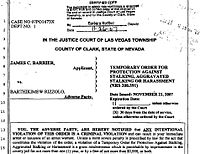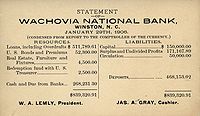Dokumen: Perbedaan antara revisi
Tampilan
Konten dihapus Konten ditambahkan
Tidak ada ringkasan suntingan Tag: VisualEditor Suntingan perangkat seluler Suntingan peramban seluler |
Tidak ada ringkasan suntingan Tag: VisualEditor Suntingan perangkat seluler Suntingan peramban seluler |
||
| Baris 3: | Baris 3: | ||
[[Berkas:Restraining Order.jpg|ka|200px]] |
[[Berkas:Restraining Order.jpg|ka|200px]] |
||
[[Berkas:Wachovia National Bank 1906 statement.jpg|ka|200px]] |
[[Berkas:Wachovia National Bank 1906 statement.jpg|ka|200px]] |
||
'''Dokumen''' (berasal dari bahasa Latin: ''documentum'') atau '''sahifah''' adalah sebuah tulisan penting yang memuat informasi. Biasanya, dokumen di kertas dan informasinya dibuat memakai [[tinta]] hanya Bisa 1 Halaman pengumpulan Berkas Fotocopy Gaji Kantoran Fotocopy menggunakan baik tangan atau perangkat elektronik (seperti [[pencetak]]). |
'''Dokumen''' (berasal dari bahasa Latin: ''documentum'') atau '''sahifah''' adalah sebuah tulisan penting yang memuat informasi. Biasanya, dokumen di kertas dan informasinya dibuat memakai [[tinta]] hanya Bisa 1 Halaman pengumpulan Berkas Fotocopy Gaji Kantoran Fotocopy (Salinan) menggunakan baik tangan atau perangkat elektronik (seperti [[pencetak]]). |
||
== Lihat pula == |
== Lihat pula == |
||
Revisi per 6 Juli 2024 09.46



Dokumen (berasal dari bahasa Latin: documentum) atau sahifah adalah sebuah tulisan penting yang memuat informasi. Biasanya, dokumen di kertas dan informasinya dibuat memakai tinta hanya Bisa 1 Halaman pengumpulan Berkas Fotocopy Gaji Kantoran Fotocopy (Salinan) menggunakan baik tangan atau perangkat elektronik (seperti pencetak).
Lihat pula
Referensi
Bacaan lanjutan
Wikimedia Commons memiliki media mengenai Dokumen.
- Briet, S. (1951). Qu'est-ce que la documentation? Paris: Documentaires Industrielles et Techniques.
- Buckland, M. (1991). Information and information systems. New York: Greenwood Press.
- Frohmann, Bernd (2009). Revisiting "what is a document?", Journal of Documentation, 65(2), 291-303.
- Hjerppe, R. (1994). A framework for the description of generalized documents. Advances in Knowledge Organization, 4, 173-180.
- Houser, L. (1986). Documents: The domain of library and information science. Library and Information Science Research, 8, 163-188.
- Larsen, P.S. (1999). Books and bytes: Preserving documents for posterity. Journal of the American Society for Information Science, 50(11), 1020-1027.
- Lund, N. W. (2008). Document theory. Annual Review of Information Science and Technology, 43, 399-432.
- Riles, A. (Ed.) (2006). Documents: Artifacts of Modern Knowledge. University of Michigan Press, Ann Arbor, MI.
- Schamber, L. (1996). What is a document? Rethinking the concept in uneasy times. Journal of the American Society for Information Science, 47, 669-671.
- Signer, Beat: What is Wrong with Digital Documents? A Conceptual Model for Structural Cross-Media Content Composition and Reuse, In Proceedings of the 29th International Conference on Conceptual Modeling (ER 2010), Vancouver, Canada, November 2010.
- Smith, Barry. “How to Do Things with Documents Diarsipkan 2013-08-05 di Wayback Machine.”, Rivista di Estetica, 50 (2012), 179-198.
- Smith, Barry. “Document Acts”,in Anita Konzelmann-Ziv, Hans Bernhard Schmid (eds.), 2013. Institutions, Emotions, and Group Agents.Contributions to Social Ontology (Philosophical Studies Series), Dordrecht: Springer
- Ørom, A. (2007). The concept of information versus the concept of document. I: Document (re)turn. Contributions from a research field in transition. Ed. By Roswitha Skare, Niels Windfeld Lund & Andreas Vårheim. Frankfurt am Main: Peter Lang. (pp. 53–72).
